Haidar Khan
ALLaM: Large Language Models for Arabic and English
Jul 22, 2024



Abstract:We present ALLaM: Arabic Large Language Model, a series of large language models to support the ecosystem of Arabic Language Technologies (ALT). ALLaM is carefully trained considering the values of language alignment and knowledge transfer at scale. Our autoregressive decoder-only architecture models demonstrate how second-language acquisition via vocabulary expansion and pretraining on a mixture of Arabic and English text can steer a model towards a new language (Arabic) without any catastrophic forgetting in the original language (English). Furthermore, we highlight the effectiveness of using parallel/translated data to aid the process of knowledge alignment between languages. Finally, we show that extensive alignment with human preferences can significantly enhance the performance of a language model compared to models of a larger scale with lower quality alignment. ALLaM achieves state-of-the-art performance in various Arabic benchmarks, including MMLU Arabic, ACVA, and Arabic Exams. Our aligned models improve both in Arabic and English from their base aligned models.
A Systematic Survey and Critical Review on Evaluating Large Language Models: Challenges, Limitations, and Recommendations
Jul 04, 2024



Abstract:Large Language Models (LLMs) have recently gained significant attention due to their remarkable capabilities in performing diverse tasks across various domains. However, a thorough evaluation of these models is crucial before deploying them in real-world applications to ensure they produce reliable performance. Despite the well-established importance of evaluating LLMs in the community, the complexity of the evaluation process has led to varied evaluation setups, causing inconsistencies in findings and interpretations. To address this, we systematically review the primary challenges and limitations causing these inconsistencies and unreliable evaluations in various steps of LLM evaluation. Based on our critical review, we present our perspectives and recommendations to ensure LLM evaluations are reproducible, reliable, and robust.
When Benchmarks are Targets: Revealing the Sensitivity of Large Language Model Leaderboards
Feb 01, 2024



Abstract:Large Language Model (LLM) leaderboards based on benchmark rankings are regularly used to guide practitioners in model selection. Often, the published leaderboard rankings are taken at face value - we show this is a (potentially costly) mistake. Under existing leaderboards, the relative performance of LLMs is highly sensitive to (often minute) details. We show that for popular multiple choice question benchmarks (e.g. MMLU) minor perturbations to the benchmark, such as changing the order of choices or the method of answer selection, result in changes in rankings up to 8 positions. We explain this phenomenon by conducting systematic experiments over three broad categories of benchmark perturbations and identifying the sources of this behavior. Our analysis results in several best-practice recommendations, including the advantage of a hybrid scoring method for answer selection. Our study highlights the dangers of relying on simple benchmark evaluations and charts the path for more robust evaluation schemes on the existing benchmarks.
Controlling the Extraction of Memorized Data from Large Language Models via Prompt-Tuning
May 19, 2023Abstract:Large Language Models (LLMs) are known to memorize significant portions of their training data. Parts of this memorized content have been shown to be extractable by simply querying the model, which poses a privacy risk. We present a novel approach which uses prompt-tuning to control the extraction rates of memorized content in LLMs. We present two prompt training strategies to increase and decrease extraction rates, which correspond to an attack and a defense, respectively. We demonstrate the effectiveness of our techniques by using models from the GPT-Neo family on a public benchmark. For the 1.3B parameter GPT-Neo model, our attack yields a 9.3 percentage point increase in extraction rate compared to our baseline. Our defense can be tuned to achieve different privacy-utility trade-offs by a user-specified hyperparameter. We achieve an extraction rate reduction of up to 97.7% relative to our baseline, with a perplexity increase of 16.9%.
Low-Resource Compositional Semantic Parsing with Concept Pretraining
Jan 30, 2023Abstract:Semantic parsing plays a key role in digital voice assistants such as Alexa, Siri, and Google Assistant by mapping natural language to structured meaning representations. When we want to improve the capabilities of a voice assistant by adding a new domain, the underlying semantic parsing model needs to be retrained using thousands of annotated examples from the new domain, which is time-consuming and expensive. In this work, we present an architecture to perform such domain adaptation automatically, with only a small amount of metadata about the new domain and without any new training data (zero-shot) or with very few examples (few-shot). We use a base seq2seq (sequence-to-sequence) architecture and augment it with a concept encoder that encodes intent and slot tags from the new domain. We also introduce a novel decoder-focused approach to pretrain seq2seq models to be concept aware using Wikidata and use it to help our model learn important concepts and perform well in low-resource settings. We report few-shot and zero-shot results for compositional semantic parsing on the TOPv2 dataset and show that our model outperforms prior approaches in few-shot settings for the TOPv2 and SNIPS datasets.
AlexaTM 20B: Few-Shot Learning Using a Large-Scale Multilingual Seq2Seq Model
Aug 03, 2022



Abstract:In this work, we demonstrate that multilingual large-scale sequence-to-sequence (seq2seq) models, pre-trained on a mixture of denoising and Causal Language Modeling (CLM) tasks, are more efficient few-shot learners than decoder-only models on various tasks. In particular, we train a 20 billion parameter multilingual seq2seq model called Alexa Teacher Model (AlexaTM 20B) and show that it achieves state-of-the-art (SOTA) performance on 1-shot summarization tasks, outperforming a much larger 540B PaLM decoder model. AlexaTM 20B also achieves SOTA in 1-shot machine translation, especially for low-resource languages, across almost all language pairs supported by the model (Arabic, English, French, German, Hindi, Italian, Japanese, Marathi, Portuguese, Spanish, Tamil, and Telugu) on Flores-101 dataset. We also show in zero-shot setting, AlexaTM 20B outperforms GPT3 (175B) on SuperGLUE and SQuADv2 datasets and provides SOTA performance on multilingual tasks such as XNLI, XCOPA, Paws-X, and XWinograd. Overall, our results present a compelling case for seq2seq models as a powerful alternative to decoder-only models for Large-scale Language Model (LLM) training.
Alexa Teacher Model: Pretraining and Distilling Multi-Billion-Parameter Encoders for Natural Language Understanding Systems
Jun 15, 2022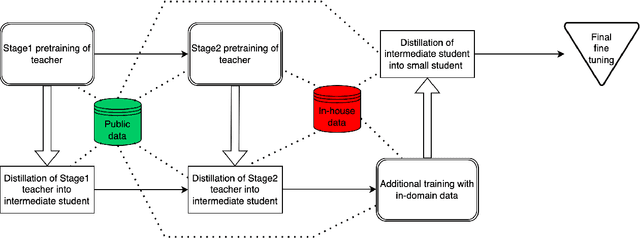
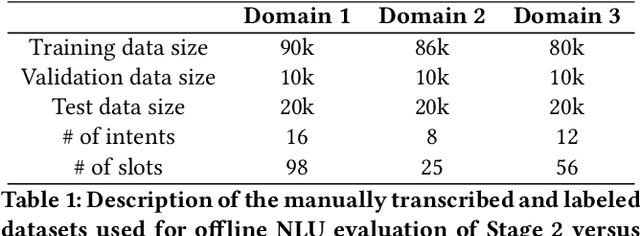
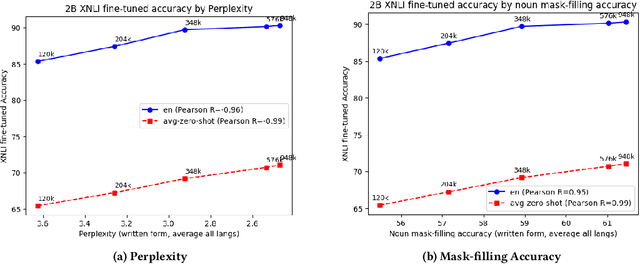
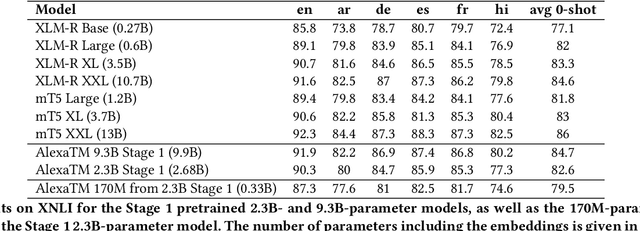
Abstract:We present results from a large-scale experiment on pretraining encoders with non-embedding parameter counts ranging from 700M to 9.3B, their subsequent distillation into smaller models ranging from 17M-170M parameters, and their application to the Natural Language Understanding (NLU) component of a virtual assistant system. Though we train using 70% spoken-form data, our teacher models perform comparably to XLM-R and mT5 when evaluated on the written-form Cross-lingual Natural Language Inference (XNLI) corpus. We perform a second stage of pretraining on our teacher models using in-domain data from our system, improving error rates by 3.86% relative for intent classification and 7.01% relative for slot filling. We find that even a 170M-parameter model distilled from our Stage 2 teacher model has 2.88% better intent classification and 7.69% better slot filling error rates when compared to the 2.3B-parameter teacher trained only on public data (Stage 1), emphasizing the importance of in-domain data for pretraining. When evaluated offline using labeled NLU data, our 17M-parameter Stage 2 distilled model outperforms both XLM-R Base (85M params) and DistillBERT (42M params) by 4.23% to 6.14%, respectively. Finally, we present results from a full virtual assistant experimentation platform, where we find that models trained using our pretraining and distillation pipeline outperform models distilled from 85M-parameter teachers by 3.74%-4.91% on an automatic measurement of full-system user dissatisfaction.
* KDD 2022
Unfreeze with Care: Space-Efficient Fine-Tuning of Semantic Parsing Models
Mar 05, 2022

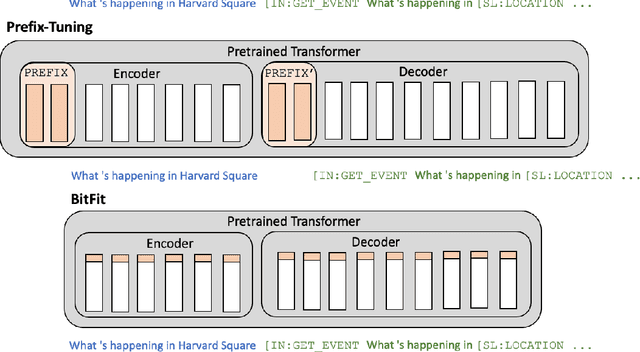

Abstract:Semantic parsing is a key NLP task that maps natural language to structured meaning representations. As in many other NLP tasks, SOTA performance in semantic parsing is now attained by fine-tuning a large pretrained language model (PLM). While effective, this approach is inefficient in the presence of multiple downstream tasks, as a new set of values for all parameters of the PLM needs to be stored for each task separately. Recent work has explored methods for adapting PLMs to downstream tasks while keeping most (or all) of their parameters frozen. We examine two such promising techniques, prefix tuning and bias-term tuning, specifically on semantic parsing. We compare them against each other on two different semantic parsing datasets, and we also compare them against full and partial fine-tuning, both in few-shot and conventional data settings. While prefix tuning is shown to do poorly for semantic parsing tasks off the shelf, we modify it by adding special token embeddings, which results in very strong performance without compromising parameter savings.
RescoreBERT: Discriminative Speech Recognition Rescoring with BERT
Feb 07, 2022



Abstract:Second-pass rescoring is an important component in automatic speech recognition (ASR) systems that is used to improve the outputs from a first-pass decoder by implementing a lattice rescoring or $n$-best re-ranking. While pretraining with a masked language model (MLM) objective has received great success in various natural language understanding (NLU) tasks, it has not gained traction as a rescoring model for ASR. Specifically, training a bidirectional model like BERT on a discriminative objective such as minimum WER (MWER) has not been explored. Here we show how to train a BERT-based rescoring model with MWER loss, to incorporate the improvements of a discriminative loss into fine-tuning of deep bidirectional pretrained models for ASR. Specifically, we propose a fusion strategy that incorporates the MLM into the discriminative training process to effectively distill knowledge from a pretrained model. We further propose an alternative discriminative loss. We name this approach RescoreBERT. On the LibriSpeech corpus, it reduces WER by 6.6%/3.4% relative on clean/other test sets over a BERT baseline without discriminative objective. We also evaluate our method on an internal dataset from a conversational agent and find that it reduces both latency and WER (by 3 to 8% relative) over an LSTM rescoring model.
Output Randomization: A Novel Defense for both White-box and Black-box Adversarial Models
Jul 08, 2021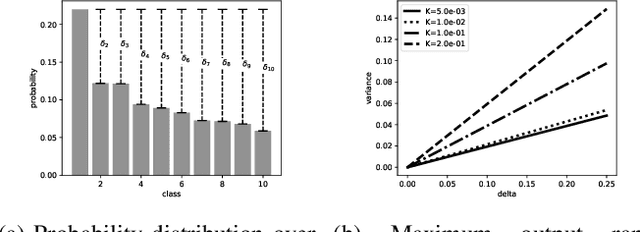
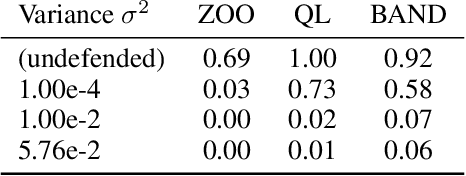
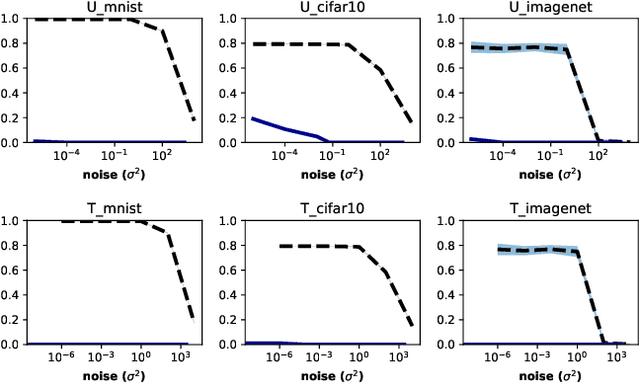

Abstract:Adversarial examples pose a threat to deep neural network models in a variety of scenarios, from settings where the adversary has complete knowledge of the model in a "white box" setting and to the opposite in a "black box" setting. In this paper, we explore the use of output randomization as a defense against attacks in both the black box and white box models and propose two defenses. In the first defense, we propose output randomization at test time to thwart finite difference attacks in black box settings. Since this type of attack relies on repeated queries to the model to estimate gradients, we investigate the use of randomization to thwart such adversaries from successfully creating adversarial examples. We empirically show that this defense can limit the success rate of a black box adversary using the Zeroth Order Optimization attack to 0%. Secondly, we propose output randomization training as a defense against white box adversaries. Unlike prior approaches that use randomization, our defense does not require its use at test time, eliminating the Backward Pass Differentiable Approximation attack, which was shown to be effective against other randomization defenses. Additionally, this defense has low overhead and is easily implemented, allowing it to be used together with other defenses across various model architectures. We evaluate output randomization training against the Projected Gradient Descent attacker and show that the defense can reduce the PGD attack's success rate down to 12% when using cross-entropy loss.
 Add to Chrome
Add to Chrome Add to Firefox
Add to Firefox Add to Edge
Add to Edge